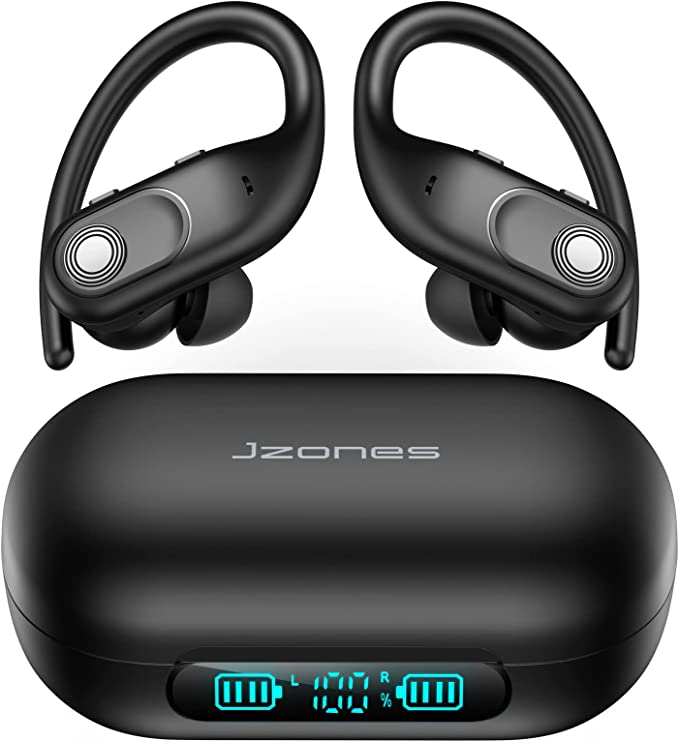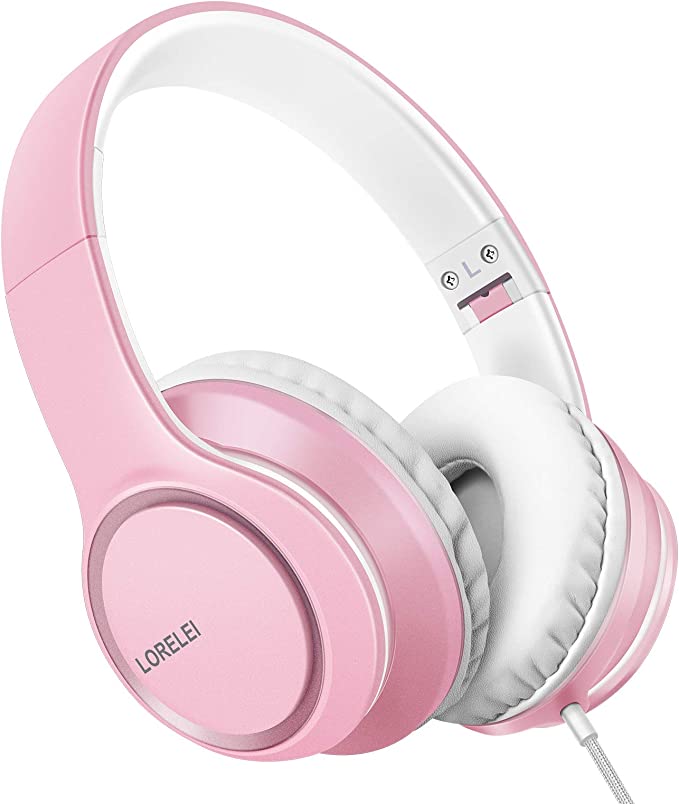In our perpetually moving world, personal audio is no longer a luxury but a constant companion. From the focused intensity of a morning run to the immersive escape of a daily commute, wireless earbuds have become the conductors of our personal soundtracks. They promise freedom, convenience, and an intimate audio experience. But have you ever paused to consider the intricate dance of science and engineering packed into these tiny devices? Let’s explore this through the lens of a specific example, the Jzones U7 Wireless Bluetooth Headphones, and unravel the technology that aims to deliver extended playtime, rich sound, and a steadfast fit for the active listener.

The Unseen Engine: Powering Boundless Audio Journeys
One of the most significant leaps in portable audio has been the untethering from power outlets, and the Jzones U7 highlights this with a claimed total playtime of up to 130 hours, courtesy of its 2500mAh charging case, while the earbuds themselves offer a respectable 8 hours per charge. This isn’t just a number; it’s a testament to advancements in battery technology.
The heart of this endurance lies in Lithium-ion (Li-ion) batteries. Since their commercialization in the early 1990s, Li-ion batteries have revolutionized portable electronics due to their remarkable energy density. Think of energy density as how much punch you can pack into a given weight or volume. Compared to older battery chemistries like Nickel-Cadmium, Li-ion can store significantly more energy, allowing for smaller, lighter devices or, as in the U7’s case, a very capacious charging case. The 2500mAh (milliampere-hour) rating of the U7’s case is a measure of its charge capacity; essentially, it signifies that the case can theoretically deliver a current of 2500 milliamperes for one hour, or any equivalent combination. This substantial reservoir is what allows it to recharge the earbuds multiple times—Jzones states up to 16 times—transforming a single wall charge into weeks of typical use for some.
The convenience extends to how the case itself is rejuvenated. It embraces both Type-C wired charging, which is rapidly becoming the universal standard for its reversibility and faster power delivery capabilities, and wireless charging. Wireless charging, typically based on the principle of electromagnetic induction, is a minor marvel of physics. Coils within a charging pad create an alternating magnetic field, which in turn induces a current in a corresponding coil within the U7’s case, replenishing its battery without the fuss of cables. It’s a seamless handshake of energy.
To keep you informed, an LED power display on the case provides an at-a-glance status of both the case’s remaining charge and the charging progress of the earbuds nestled within. It’s a small but crucial piece of user-centric design, removing the guesswork from your power management. And in a thoughtful touch, the case itself can act as an emergency power bank for your phone. While it won’t replace a dedicated high-capacity power bank, in a tight spot, having that extra lifeline drawing from the U7’s substantial battery reserves can be incredibly useful. This involves a step-up DC-to-DC converter within the case to provide the appropriate voltage for phone charging, though some energy is always lost in this conversion process.
For the user, these features translate into a profound sense of freedom. Imagine embarking on a long-haul flight or a week-long hiking trip, confident that your audio companion won’t desert you. This extended autonomy directly addresses the “battery anxiety” that plagues users of many portable gadgets.

Crafting Your Personal Soundscape: The Nuances of Hi-Fi and Clear Communication
Beyond endurance, the soul of any headphone lies in its ability to reproduce sound. The Jzones U7 earbuds are equipped with 10mm speaker drivers and aim for “Hi-Fi stereo bass” and “crystal-clear calling.” Let’s decode this.
The driver is the workhorse of an earphone, a miniature loudspeaker that converts electrical signals from your audio source into the sound waves that your ears interpret. The 10mm diameter of the U7’s drivers is relatively generous for an in-ear design. Generally, a larger driver diaphragm has the potential to move more air, which can be particularly beneficial for reproducing lower frequencies, contributing to that “deep bass” sensation. However, driver size is just one ingredient in a complex recipe; the driver material, magnet strength, and acoustic enclosure design all play critical roles.
The term “Hi-Fi” (High-Fidelity) has been part of the audio lexicon since the mid-20th century, originally referring to audio equipment that could reproduce recordings with minimal distortion and a flat frequency response, meaning it didn’t unduly emphasize or suppress any particular range of sounds. In the context of modern earbuds like the U7, it signifies an aspiration to deliver a sound that is faithful to the original recording, allowing you to hear the punch of the kick drum, the shimmer of the cymbals, and the nuances of a vocalist’s performance. This involves not just the hardware, but also the digital-to-analog conversion and amplification stages, which must be engineered to preserve the integrity of the audio signal. While a truly audiophile-grade Hi-Fi experience often involves dedicated, high-end equipment, the goal for earbuds like the U7 is to bring a more engaging and detailed listening experience to everyday users.
When it comess to calls, the U7 product description mentions “noise-canceling calls.” It’s crucial to distinguish this from Active Noise Cancellation (ANC) that silences the listener’s environment. “Noise-canceling calls” typically refers to technologies that focus on the clarity of your voice for the person on the other end. This often involves multiple microphones and a Digital Signal Processor (DSP). One microphone might be positioned to primarily capture your voice, while others pick up ambient sounds. The DSP then uses algorithms (often a form of Environmental Noise Cancellation, or ENC) to analyze these signals, identify the characteristics of speech versus noise, and suppress the unwanted background cacophony—be it wind noise, office chatter, or traffic rumble. The result? Your voice cuts through more clearly, making for less frustrating conversations, especially when you’re out and about. This technology has become increasingly sophisticated, making hands-free calls viable in environments that would have been impossible just a few years ago.
For the listener, this translates to potentially richer music enjoyment and more productive, clearer conversations – whether you’re dissecting the complexities of a classical piece or coordinating plans on a busy street.

Engineered for Life in Motion: The Dance of Ergonomics and Resilience
For many, wireless earbuds are companions for an active lifestyle. This is where ergonomics and durability, as highlighted by the Jzones U7’s ergonomic silicone earhooks and IPX7 waterproof rating, become paramount.
Ergonomics is the applied science of designing products, systems, or processes to optimize human well-being and overall system performance. When applied to earbuds, especially those intended for sports, this means ensuring a secure, comfortable fit that can withstand vigorous movement without causing discomfort or falling out. The U7’s over-ear hook design is a classic approach to stability. These hooks, made of silicone, distribute the earbud’s weight and anchor it more effectively than earbuds that rely solely on an in-ear seal. Silicone itself is a fascinating material; it’s a polymer that exhibits excellent flexibility, biocompatibility (reducing the risk of skin irritation for most people), temperature resistance, and durability. The “super lightweight” claim further contributes to comfort during extended wear. Combined with the provision of three pairs of different-sized ear caps, users can tailor the fit for an optimal acoustic seal—which is vital not only for comfort and security but also for maximizing bass response and passive noise isolation.
Then there’s the IPX7 waterproof rating. The IP Code, or Ingress Protection Code, is an international standard (IEC 60529) that classifies the degrees of protection provided by enclosures of electrical equipment against the intrusion of solid objects (like dust) and liquids. In “IPX7,” the “X” means there’s no specific rating provided for dust protection (or it’s not a marketed feature), while the “7” denotes a high level of liquid ingress protection. Specifically, an IPX7 rating means the device can withstand immersion in water up to 1 meter (about 3.3 feet) for a maximum of 30 minutes under specified conditions of pressure and time. This testing is rigorous. It doesn’t mean you should go swimming with the U7s, but it provides significant peace of mind against heavy sweat during intense workouts, an unexpected downpour during a run, or even an accidental quick drop into a puddle. The product description also mentions an “internal nano-coating.” Such coatings are hydrophobic (water-repelling) layers applied to the internal components, offering an additional line of defense by preventing airborne moisture or small splashes from causing damage even if some liquid were to get past the outer seals.
The value here is clear: the freedom to move, exercise, and brave the elements without constantly worrying about your earbuds. Whether you’re a dedicated runner, a gym enthusiast, or simply someone who appreciates robust gear, these design considerations are critical.

The Invisible Handshake: The Elegance of Seamless Connectivity
The final piece of the puzzle for a truly satisfying wireless experience is how effortlessly the earbuds integrate into your digital life. The Jzones U7 highlights “Latest One-step Pairing Technology” and straightforward controls.
Bluetooth, the wireless technology underpinning this connection, is a marvel of short-range radio communication. Named after the 10th-century Danish king Harald Bluetooth, famed for uniting disparate Danish tribes, the technology similarly aims to unite devices. It operates in the 2.4 GHz ISM (Industrial, Scientific, and Medical) radio band, using frequency hopping to mitigate interference. “One-step pairing” simplifies the initial setup. While older Bluetooth devices sometimes required arcane button presses and PIN codes, modern earbuds like the U7 often initiate pairing mode automatically when the case is opened for the first time. Subsequent connections are then usually automatic: open the case, and the earbuds swiftly reconnect to your paired device. This ease of use removes a significant point of friction that once deterred some users from wireless audio.
Once connected, interaction is managed via a multi-function button on each earbud. This tactile interface allows for control over music playback (play/pause, track skipping, volume adjustment) and call management (answer, reject, end call) without needing to reach for your phone. This is part of a broader trend in wearable technology towards minimalist, intuitive controls that allow users to stay engaged in their current activity.
The practical benefit is a smoother, less intrusive interaction with your technology. It’s about the earbuds fading into the background, becoming an extension of your ability to listen and communicate, rather than a device demanding constant attention.
To keep this sophisticated technology working optimally, the “Usage Guide and Precautions” provided with the U7 offers sensible advice. For instance, avoiding environments with strong electromagnetic fields or multiple 2.4GHz signals helps maintain Bluetooth signal integrity, as these can cause interference, leading to stuttering audio. Keeping the battery from frequently dropping below 10% and charging the earbuds at least once every 30 days if unused for extended periods are good practices for Lithium-ion battery health, helping to preserve their capacity over time. Ensuring the charging contacts are clean is also vital, especially with an IPX7 rating, as residue can impede charging.

The Evolving Soundscape
The Jzones Jzones U7 Wireless Bluetooth Headphones, like many contemporary personal audio devices, encapsulate a convergence of advancements in battery science, acoustic engineering, material science, and wireless communication. Understanding the principles behind their features—the energy density of their Li-ion cells, the physics of their speaker drivers, the resilience offered by IPX7 waterproofing, and the seamlessness of modern Bluetooth—doesn’t just demystify the technology; it empowers us as consumers. It allows us to appreciate the intricate engineering designed to enhance our daily lives, one song, one podcast, one call at a time, all while navigating the vibrant, often demanding, rhythm of the modern world. As technology continues to evolve, the quest for even longer battery life, more immersive sound, and ever more intuitive interaction will undoubtedly lead to new innovations, further refining our personal audio experiences.




